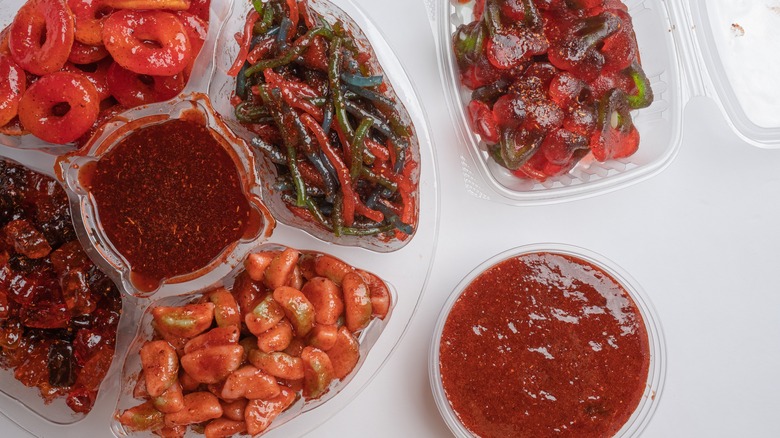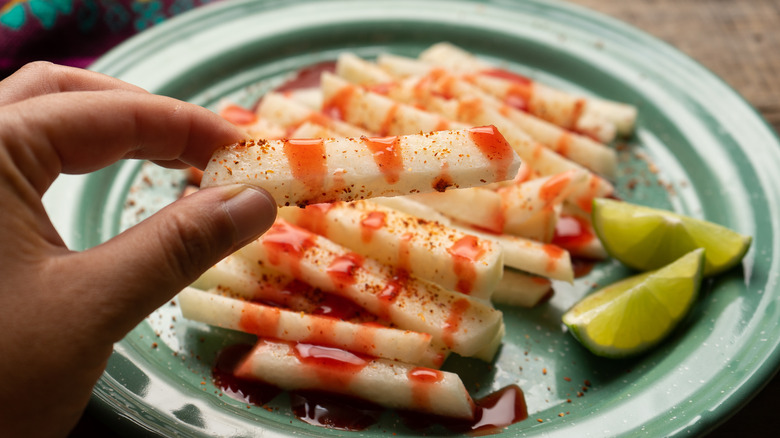Chamoy: The Spicy-Sweet Mexican Sauce That Goes With Almost Anything
Mexican cuisine is often beloved for its spicy flavors that blend intricately yet seamlessly. However, the country's tastes encompass more than heat; and cooks don't only rely on incendiary ingredients. Some recipes are sweet, sour, or salty, while others have a mixture of all these attributes. One example of the latter is chamoy, the spicy-sweet Mexican sauce that goes with pretty much anything. Its distinct flavor comes from pickled fruits, limes, chiles, and other ingredients.
Along with alambre, escamoles, and pejelagarto asado, chamoy might be one of those Mexican foods you didn't know existed. In the U.S., the sauce isn't as popular as salsa or guacamole, but it's a staple of Mexican cuisine. Its subtle sweetness balances out the sour and spicy components, creating a unique flavor that complements paletas, sorbets, fruit salads, ice cream, and snacks. Chamoy can also be a wonderful addition to cocktails, mocktails, beer, and granitas.
Need one more reason to give it a try? Chamoy is easy on the wallet and can be prepared at home, too. Plus, it pairs well with both fruits and vegetables, meaning you can drizzle it over fries, cucumbers, veggie sticks, and sliced papaya or watermelon for extra flavor.
A star ingredient in Mexican cuisine
Chamoy was seemingly invented in the 1950s by a Japanese immigrant named Teikichi Iwadare. However, its exact origins are uncertain. Traditionally, the condiment is made from pickled apricots, prunes, plums, or mangos, plus lime juice and chiles. Some recipes may also call for sugar, tamarind, dried fruits, or apple cider vinegar. Therefore, its flavor and texture vary slightly depending on the ingredients used.
The condiment is available as a sauce, paste, or powder, and some vendors sell it as candy, popsicles, or shaved ice. Its popularity rose in the 1970s when Dulces Miguelito, a Mexican candy manufacturer, began to mass-produce chamoy. Soon it became a key ingredient in saladitos, a snack made with dried and salted fruits, as well as other traditional treats, such as Sabritas chips. "It's typical of the Mexican palate — they want all of the different taste buds going off at the same time. And chamoy ties all of that in," chef Dominica Salomon (now Dominica Rice-Cisneros) told NPR.
Its flavor is truly unique, with varying levels of spiciness and sweetness. The sauce has a thick consistency similar to that of ketchup. The paste is even thicker, but you can dilute it with water and add it to stews, meat dishes, or roasted veggies. The powder, on the other hand, can be sprinkled over fresh fruits, vegetables, and chips, or mixed into beverages. For example, you can use either chamoy powder or sauce in a chili-spiced watermelon rosé granita.
How to employ chamoy
Chamoy goes well with both sweet and savory dishes, from baked apples to popcorn, tacos, and nachos. You can use it as a dipping sauce for fresh fruits or veggies, drizzle it over fries, or pour it over homemade ice cream and cookies. Some foodies also incorporate it into cooked meals, such as pork tenderloin, chicken wings, or glazed salmon. In San Antonio, Texas, it's a chicken salad ingredient. Meanwhile, street vendors in Mexico City and elsewhere add chamoy to Doritos and Tostitos chips for Dorilocos and Tostilocos, a flavorful snack that also often includes Japanese peanuts, queso fresco, and gummy candy.
The condiment can add flavor to vodka-based drinks, tequila, mezcal, and micheladas. Another option is to blend chamoy sauce, mango, lime juice, and coconut milk to make a mangonada. With its sweet and tangy flavors, chamoy will complement the natural sweetness of the fruits while adding a spicy kick.
As far as storage goes, you can either refrigerate the store-bought sauce or keep it in a cool, dry place. Alternatively, pour it into ice cube trays and freeze it for later use. If you ever run out, you can prepare some at home using a few basic ingredients. All you need is apricot jam or pickled fruits, chili powder, sugar, and fresh lime juice. Just keep in mind that homemade chamoy doesn't have preservatives and should be kept in the fridge to extend its shelf life.


